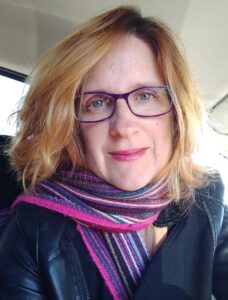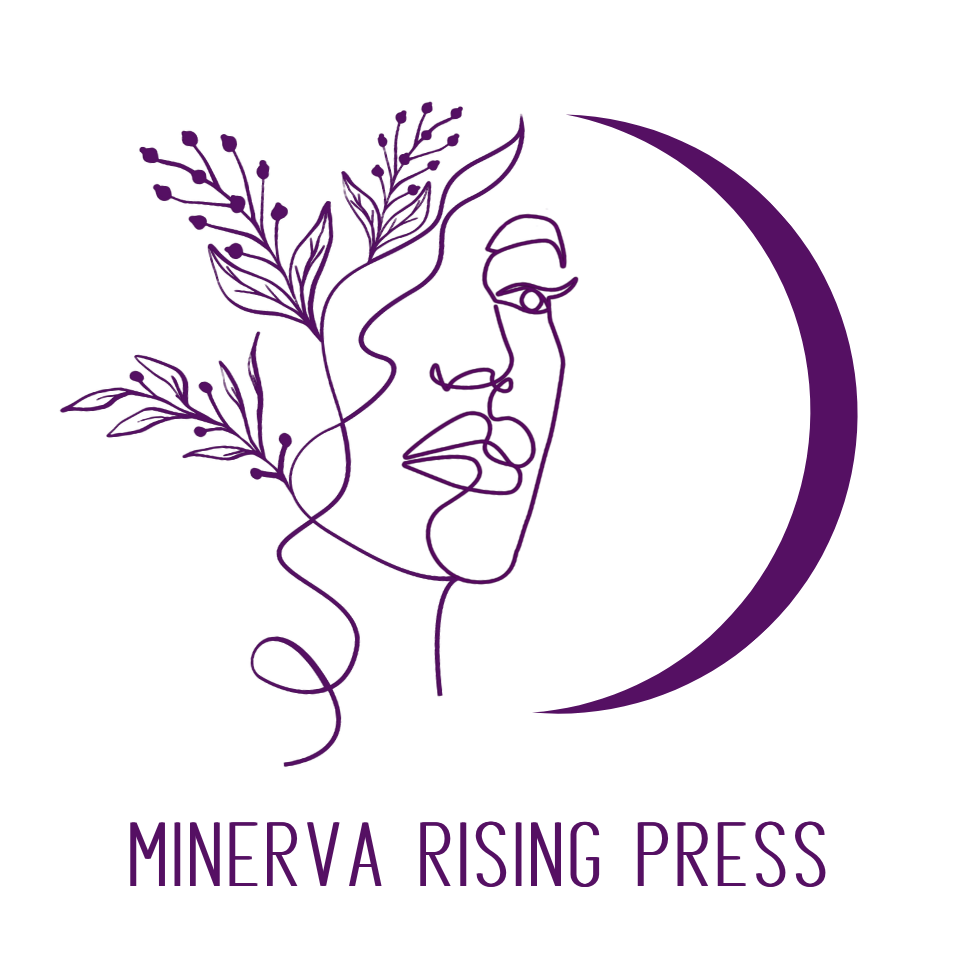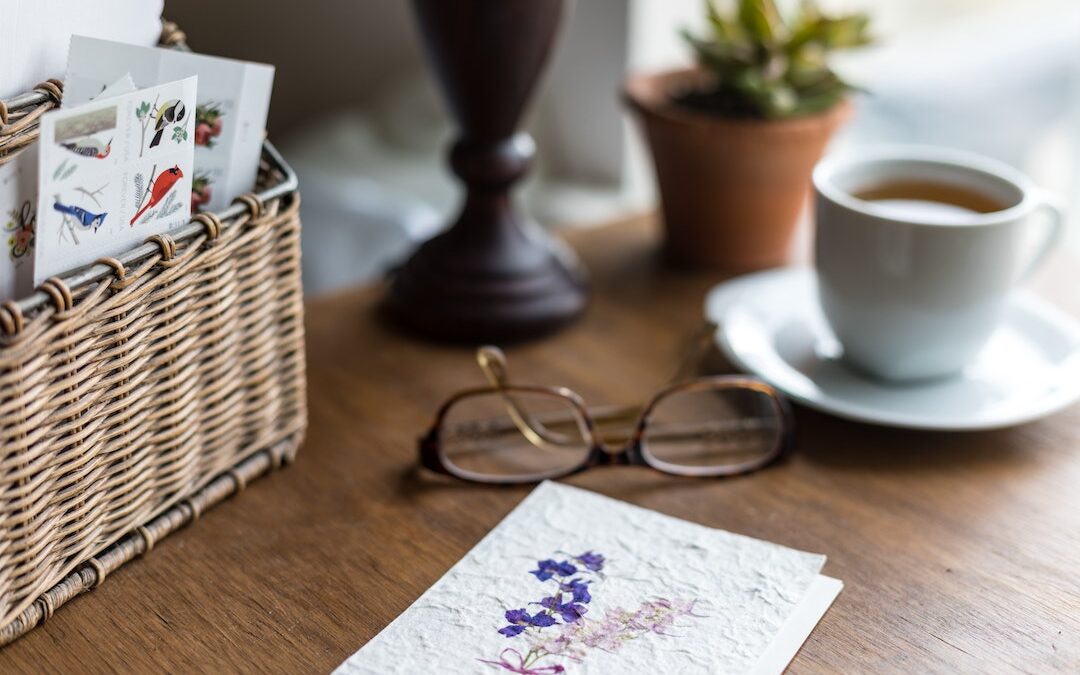When my Aunt Ada sits down to write to me, she’ll start with the weather: “Greetings on this cold and rainy Tuesday morning at 10:30 . . .” She might finally conclude the letter with a Friday afternoon postscript. As she nears the end of the fourth or sixth or eighth numbered page—they’re always an even number of pages because she fills both sides, it being a waste of paper not to do so—her writing, always small and neat, gets even smaller and narrower. I imagine her weighing in her mind the length of the one more story she wants to tell against the number of lines left on the paper and adjusting accordingly to make it all come out at the end. Her closing “Sincerely, Ada Marie” graces the bottom right-hand corner in her tiny script.
Aunt Ada, my mother’s next-oldest sister, corresponds with possibly hundreds of people and has done so for most of her life. I’m only an observer of Amish culture; my mother left the Amish church and became a more liberal Mennonite before she met my dad. But in my experience, Amish community life is based around relationships and talking—lots of talking. The Amish spend much of their time in conversation with others in their large families and community while they work and worship. Their free hours are spent visiting each other and socializing some more.
Ada does her part to nurture an intricate web of friends and relatives around the country and overseas. Having no television, radio, or computer, and little access to reading material beyond the Bible, some church study materials, and The Budget—the international Amish newspaper out of Holmes County, Ohio—she has time for this mission of hers – to hold the world together and keep the relationships strong, especially with those at a distance. So she’s been writing to me my whole life, keeping up with my changing address and my sons’ ages, sharing the news of the rest of the family with me, especially since I became a Baha’i as a young adult and she is concerned for my soul.
Mom died this spring at eighty-nine, and Aunt Ada, just a year younger, has reached out more frequently to me during her decline and since her death. Thus when I received not one but two long letters from her in June and July, I put off reading them, knowing the time and concentration they would require. I hadn’t gotten around to reading these letters until early August. It wasn’t that I wasn’t interested; it’s a commitment to read Ada’s letters. I can’t absorb them while watching the news or watering the flowers; it would be disrespectful. I want to actually sit down with a cup of tea by the window and read them aloud, fully take them in.
And Ada’s letters are especially precious now, since the death of my mom. She is more like my mother than their other siblings. Her voice is similar, clear and sharp, lively, and sometimes biting. Ada tells it like it is, just like Mom did. Her self-deprecating sense of humor and love of a story is like Mom’s, too. They both like to hold court and invite others to enjoy a good laugh at their own misadventures. Her July letter says: “Maybe I can fill this sheet by telling you about my sudden landing on a hard floor. Not sure why I fell. I can no longer be considered a totally white woman. My right arm and shoulder, also my left leg have some very colorful decorations.”
Unlike Mom, though, whose memories evaporated over the course of twenty years until she forgot even her favorite stories—the one about my father and the skunk, the one about her first plane ride when I was a month old, the one about the time she accidentally rode a pig—Ada never forgets anything.
It’s probably all the writing she’s done. In addition to continual letter writing, Ada keeps a journal as well and has done so all these years. So everything of note that ever happened to her or anyone she knew got recorded there in longhand. She’d not just record it; she’d craft the story for an audience and revise and polish it when she shared it in letters and gatherings. I think she’s a writer at heart.
One trait she and Mom shared was a love of the exact details. It’s all in the numbers. Ada can tell you the month her oldest son first complained of feeling so tired, the date he was diagnosed with leukemia, how many days he was in the hospital, the exact time he drew his last breath, thirty-eight years ago. Her July letter says, “On July 8th it will be 55 years since Sister Esther and Baby Lyle, 4 months old, were killed. [The family’s buggy was rear-ended by a speeding car.] She was 31. . . . Then 11 months later was when John’s [Esther’s husband] left arm was cut off [in a sawmill accident]. He came home from the hospital the day it was a year that Esther was killed.”
Her latest letters include the temperatures, the highs and lows. She notes the two and a quarter inches of rain, the eleven and a half hours it took to get from her house to her cousin’s in Ohio, the 316 guests at her oldest granddaughter’s wedding in May. She can tell you how many people sat around her table for dinner on any given Sunday, and that her son Nathan and daughter-in-law Angela’s strawberry bed produced 146 gallons of strawberries this summer, all of them stemmed and sliced and frozen, or made into jam. She doesn’t say how many jars of jam, but if I asked her, I’ll bet she could tell me.
She shares in her July letter that she misses her Saturday morning calls to my mom, though toward the end Mom couldn’t understand her or respond much to her stories. Still, Ada faithfully made those weekly calls, in which she regaled her sister with stories old and new. During my video chats with Mom, she often said, “I talked to Ada on Saturday. . . Well, she talked, and I listened.” And we would both laugh. I never called Ada unless I had an hour to spare.
I was with Mom in those last hours just before her death. I got to Kansas and Mom’s bedside on Thursday afternoon, April 22, around 4:00. I had arranged to call Ada on Friday morning at 8:00; she was going to be at a school function with the community on Thursday and get in late.
I was at Mom’s side alone overnight; my brother and father were already on the other side, and the suddenness of her decline, Covid restrictions, and age made travel hard for other members of the family. So I was relieved to call Ada Friday morning, right at 8:00 as she’d asked, to share the unfolding story. I filled her in on my trip from California, when I’d gotten in, what the chaplain had done, what had happened during the night.
I finished my report, and then I put the phone to my mother’s ear so Ada could talk to her one more time. Mom hadn’t been responsive since I got there, except to raise her eyebrows when I first arrived and spoke to her and stroked her hair. So I told Ada she wouldn’t be able to respond, but the hospice nurse said she could probably still hear and understand us.
I couldn’t hear what Ada said to Mom, but I soaked up her muffled voice like a parched plant. She talked for a few minutes, her voice clear and matter-of-fact and full of courage and love. It didn’t seem right, somehow, to listen in on this final conversation between sisters who’ve shared eighty-eight years.
Then I sat by the bed with my phone to my ear and watched Mom as I told Ada how relieved I was that I’d made it there in time, about what the doctor had said, about the kind staff there, about what was going to happen and that it would happen anytime now. I talked about possible funeral dates and arrangements to be made. I was so grateful for Ada’s ear, so grateful to have someone take note of the details, the numbers, the timeline, to be my co-witness to this mysterious journey. We had all been preparing for a long time.
And then, as we talked, Mom took a deep breath and paused as seconds stretched out. I stopped breathing too. “Ada, I think she’s going,” I said. Mom finally took another breath, shrugging, her shoulders and neck lifting as her spirit tugged free. Then she was still.
I narrated the details to Ada with wonder and reverence. “Is that right?” said Ada, breathlessly. “Is that right?” She was speechless for once, and we inhaled quietly together. I looked at the clock. “It’s 8:42,” I finally told Ada. “It’s Friday, April 23, and it’s 8:42 in the morning. It’s so beautiful outside. The redbuds are blooming.” I know she’ll share it all with the others for me, recording it for posterity. It’s what she does.
 Michelle Goering has been writing forever, but only for herself until recently. She is a musician with a background in publishing, married, and the mother of twin college-age sons. A San Diego resident from a Kansas farm, she has been published in Sasee, Communion Arts Journal, and Motherwell Magazine.
Michelle Goering has been writing forever, but only for herself until recently. She is a musician with a background in publishing, married, and the mother of twin college-age sons. A San Diego resident from a Kansas farm, she has been published in Sasee, Communion Arts Journal, and Motherwell Magazine.

